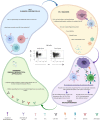PD/1-PD-Ls Checkpoint: Insight on the Potential Role of NK Cells
- PMID: 31214193
- PMCID: PMC6557993
- DOI: 10.3389/fimmu.2019.01242
PD/1-PD-Ls Checkpoint: Insight on the Potential Role of NK Cells
Abstract
The identification of inhibitory NK cell receptors specific for HLA-I molecules (KIRs and NKG2A) provided the molecular basis for clarifying the mechanism by which NK cells kill transformed cells while sparing normal cells. The direct interactions between inhibitory NK cell receptors and their HLA-I ligands enable NK cells to distinguish healthy from transformed cells, which frequently show an altered expression of HLA-I molecules. Indeed, NK cells can kill cancer cells that have lost, or under express, HLA-I molecules, but not cells maintaining their expression. In this last case, it is possible to use anti-KIR or anti-NKG2A monoclonal antibodies to block the inhibitory signals generated by these receptors and to restore the anti-tumor NK cell activity. These treatments fall within the context of the new immunotherapeutic strategies known as "immune checkpoint blockade." These antibodies are currently used in clinical trials in the treatment of both hematological and solid tumors. However, a more complex scenario has recently emerged. For example, NK cells can also express additional immune checkpoints, including PD-1, that was originally described on T lymphocytes, and whose ligands (PD-Ls) are usually overexpressed on tumor cells. Thus, it appears that the activation of NK cells and their potentially harmful effector functions are under the control of different immune checkpoints and their simultaneous expression could provide additional levels of suppression to anti-tumor NK cell responses. This review is focused on PD-1 immune checkpoint in NK cells, its potential role in immunosuppression, and the therapeutic strategies to recover NK cell cytotoxicity and anti-tumor effect.
Keywords: KIR; NK cells; NKG2A; PD-1; PD-L; immune checkpoint; immune checkpoint blockade; immunotherapy.
Figures
Similar articles
-
Human NK cells: surface receptors, inhibitory checkpoints, and translational applications.Cell Mol Immunol. 2019 May;16(5):430-441. doi: 10.1038/s41423-019-0206-4. Epub 2019 Feb 18. Cell Mol Immunol. 2019. PMID: 30778167 Free PMC article. Review.
-
Targeting Checkpoint Receptors and Molecules for Therapeutic Modulation of Natural Killer Cells.Front Immunol. 2018 Sep 10;9:2041. doi: 10.3389/fimmu.2018.02041. eCollection 2018. Front Immunol. 2018. PMID: 30250471 Free PMC article. Review.
-
Human NK cells: From surface receptors to clinical applications.Immunol Lett. 2016 Oct;178:15-9. doi: 10.1016/j.imlet.2016.05.007. Epub 2016 May 13. Immunol Lett. 2016. PMID: 27185471
-
PD-1 mediates functional exhaustion of activated NK cells in patients with Kaposi sarcoma.Oncotarget. 2016 Nov 8;7(45):72961-72977. doi: 10.18632/oncotarget.12150. Oncotarget. 2016. PMID: 27662664 Free PMC article.
-
Unlocking the therapeutic potential of the NKG2A-HLA-E immune checkpoint pathway in T cells and NK cells for cancer immunotherapy.J Immunother Cancer. 2024 Oct 31;12(10):e009934. doi: 10.1136/jitc-2024-009934. J Immunother Cancer. 2024. PMID: 39486805 Free PMC article. Review.
Cited by
-
Circulating Biomarkers of Response and Toxicity of Immunotherapy in Advanced Non-Small Cell Lung Cancer (NSCLC): A Comprehensive Review.Cancers (Basel). 2021 Apr 9;13(8):1794. doi: 10.3390/cancers13081794. Cancers (Basel). 2021. PMID: 33918661 Free PMC article. Review.
-
Case Report: A Peculiar Case of Inflammatory Colitis After SARS-CoV-2 Infection.Front Immunol. 2022 Feb 9;13:849140. doi: 10.3389/fimmu.2022.849140. eCollection 2022. Front Immunol. 2022. PMID: 35222440 Free PMC article.
-
Alterations in Natural Killer Cells in Colorectal Cancer Patients with Stroma AReactive Invasion Front Areas (SARIFA).Cancers (Basel). 2023 Feb 3;15(3):994. doi: 10.3390/cancers15030994. Cancers (Basel). 2023. PMID: 36765951 Free PMC article.
-
Programmed cell death protein 1 on natural killer cells: fact or fiction?J Clin Invest. 2020 Jun 1;130(6):2816-2819. doi: 10.1172/JCI137051. J Clin Invest. 2020. PMID: 32391808 Free PMC article.
-
NK-92MI Cells Engineered with Anti-claudin-6 Chimeric Antigen Receptors in Immunotherapy for Ovarian Cancer.Int J Biol Sci. 2024 Feb 11;20(5):1578-1601. doi: 10.7150/ijbs.88539. eCollection 2024. Int J Biol Sci. 2024. PMID: 38481806 Free PMC article.
References
Publication types
MeSH terms
Substances
LinkOut - more resources
Full Text Sources
Other Literature Sources
Research Materials


